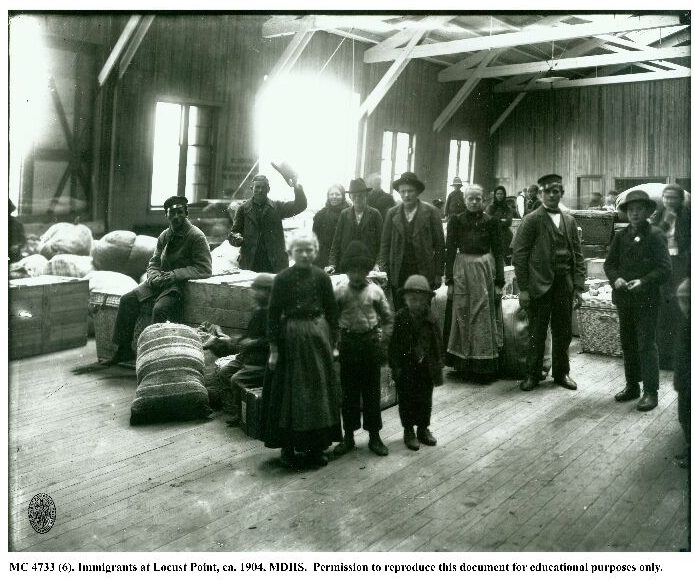Sepia Saturday 409: Second in a series about my Welsh immigrant great grandfather Francis Hugh Owen, who married into the Irish Dempsey family in Baltimore, Maryland.
My Welsh immigrant great grandfather Francis Hugh “Frank” Owen left Wales in the late 1800s and ended up in Baltimore City, Maryland — probably debarking at Locust Point, which was the city’s deep-water port of entry after 1850.
From there, new arrivals could board trains carrying them further west — or stay and take their chances in the big city, which is what my ancestor did.

When did he emigrate?
Exactly when Frank made his fateful trip is unclear — but it appears he arrived in Baltimore on the cusp of the hard-to-document period between the 1880 and 1900 U.S. federal censuses.
I have not yet found him in Baltimore City’s 1880 federal census. And Frank’s immigration year, as well as his age, varies in later Baltimore federal census returns that asked about immigration and citizenship status — the only sources for this information I have located so far.
| Francis Hugh “Frank” Owen’s Immigration Details – Excerpted from U.S. Censuses of Baltimore City, Md. – Source: FamilySearch.org | |||
| Census Year | Age | Immigration year | Citizenship |
| 1910 | 50 | 1884 | Not Naturalized |
| 1920 | 60 | 1879 | Naturalized 1886 |
| 1930 | 75 | 1883 | Naturalized |
| 1940 | 89 | — | Foreign born, American at birth |
Why did he leave Wales?
I wondered what was going on in Wales that may have precipitated Frank’s departure from his homeland during the 1879-1884 window shown in the U.S. censuses.
Why would he leave the land of his proud people — the builders of Stonehenge who spoke one of the oldest surviving languages in Europe — to cast his lot in the U.S.?

I found an answer in a course module on OpenLearn Cymru: Free Learning from the Open University In Wales describing a population explosion in Wales around the time of Frank’s departure — and its demographic impact, which I have underlined:
In 1801 the population of Wales was 587,245; in 1851, 1,163,000; in 1901, 2,013,000. The nineteenth-century pattern, therefore, was for population to double in the first half century, and then to (almost) double again in the second half: this roughly reflected the pattern for Great Britain as a whole. For Wales, the most dramatic increase came at the end of our period. In the single decade from 1901 to 1911 the population of Wales increased by over 400,000 people. Wales thus, at least fully shared in the general nineteenth-century population explosion. It also experienced the general tendency for population to be redistributed: in the case of Wales this took the form of the balance of the population slipping towards the bottom.
An economic emigration
Although the population increase was linked to public health improvements — which brought a falling death rate and rising birth rate — it apparently also contributed to a move off the land in rural areas of Wales that began in roughly 1880.
These developments may have created a perfect storm of economic pressures on a Welsh young man like Frank — prompting him to board a ship to the U.S. in hopes of better fortunes than could be had by “slipping towards the bottom” back home.
Thus he landed in Baltimore City, Md., where soon enough he would marry into the Dempsey family and start a new life for himself.
More on Frank’s Baltimore family in the next post. Meanwhile, please visit the blogs of this week’s other Sepia Saturday participants here.
© 2018 Molly Charboneau. All rights reserved.

I have wondered about my great-grandmother and her sisters who emigrated from Ireland to New York in the late 1800s. They all arrived in different years, not traveling together. My theory is that they had to save money over time and as soon as a girl turned 16 or 18, off she went to America. Were their parents still living? I don’t know. Mine were not potato famine immigrants as they were born after that. Your research on Wales inspires me to take another look at the conditions in Ireland.
My great grandmother came to the U.S. with her five youngest children – 4 daughters and a boy (my grandfather) – landing in Rhode Island in the latter 1800s – leaving her husband and seven older children behind in England. We have never been able to find out why she left with the younger children, leaving the others behind? The adults and older children all worked in the cotton mills in Blackburn so perhaps she was seeking a better life for the younger children, but why leave the others behind – including her husband? Were they to follow later but never did or could? I wish we knew more.
I did not know that Baltimore was such an important entry port for immigrants. Parts of my family roots are in the Baltimore/Chesapeake area and I expect they encountered foreign families passing through from time to time. Pressure from expanding populations, agriculture failures, war, etc. inevitably force people to look for a better home. The struggle is no different now than it was then.
Interesting story of Frank’s history.
Wonderful to read about your ancestor, as well as to have some significant photos. I just found some ancestors who came to America through Baltimore, and hadn’t any information about that area before. Thanks. I like what Tony said, that the best travel furthest…it stands to reason.
i always think it’s the Brghtest & the Best who travel the furthest when the going gets tough.
I think Frank’s journey is a facinating one.Thanks ,Molly, for continuing to share it here.